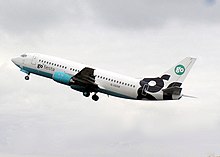Go (airline)
 | |||||||
| |||||||
| Founded | 1998 | ||||||
|---|---|---|---|---|---|---|---|
| Ceased operations | 2005 (merged into EasyJet) | ||||||
| Hubs | London Stansted Bristol Airport | ||||||
| Fleet size | 28 | ||||||
| Destinations | Mainland Europe | ||||||
| Parent company |
| ||||||
| Headquarters | London Stansted Airport Essex | ||||||
| Key people | Barbara Cassani Bob Ayling Rod Eddington | ||||||
| Website | go-fly.com | ||||||
Go Fly (styled and trading as Go) was the name of a British low-cost airline, founded by British Airways in 1998. It operated flights between London Stansted Airport and destinations in Europe. The airline was purchased from BA in a management buyout backed by the private equity firm 3i in 2001. In 2002, it was bought by its rival EasyJet and was merged into that airline's operations by 2003.[1][2]
Its head office was in Enterprise House at London Stansted Airport in Stansted Mountfitchet, Essex.[3]
History[edit]


Bob Ayling, CEO of British Airways, approached EasyJet founder Stelios Haji-Ioannou to ask whether they could meet, claiming that he was fascinated by how the Greek entrepreneur had made the budget airline formula work. Haji-Ioannou not only agreed, but allegedly showed Ayling his business plan.[4]
In 1997, BA announced that, under the project name Operation Blue Sky, it would launch its own low-cost airline to meet the changing demand for air travel in Europe.[5] According to Ayling, the new airline would "quickly become a favourite with the budget traveller" via its pricing scheme and available flights.[6] Barbara Cassani, who had been British Airways' General Manager in New York and had been credited with turning around the airline's flagging fortunes in the transatlantic market in the early 1990s, was chosen by Ayling to set up the new venture. The new airline would be run separately from British Airways as a wholly owned subsidiary, and would compete in the European low-cost carrier market, dominated by Ryanair and EasyJet. In 1998, the name of the new airline was announced as Go Fly Limited, following a lengthy debate over how to choose a name that would best suit the positioning of this new airline, which was already facing challenges from EasyJet,[7] and Virgin Atlantic,[8] among others.
The airline's fleet consisted of Boeing 737s. The first two, 737-300s G-IGOC and G-IGOE,[9] were acquired via lease from Philippine Airlines.[10]
An additional plane, a 737-3Q8 G-IGOF, was leased in 1998.[9] On Friday 22 May 1998, Go flew for the first time from its base at London Stansted Airport to Rome Ciampino. The following afternoon saw the airline's inaugural flight to Milan Malpensa Airport. The Italian launch of Go's operation was managed by former American Airlines executive Luca Berti.[citation needed]
As part of EasyJet's campaign against Go, Haji-Ioannou and nine other EasyJet staff booked tickets for the flight, arriving in orange boiler suits.[9][11] Other early routes were to Copenhagen, Bologna and Lisbon.[9] In July flights to Glasgow were started, then to Munich in November and Venice in December 1998, followed by Málaga, Faro, Bilbao in April 1999 and Madrid.[9]
After leasing three further planes, including a former Air Liberté plane and another ex-British Midland jet in 1998 and 1999, six additional planes were delivered direct from Boeing, leased from GE Commercial Aviation Services, bringing the total to 13. Although this was four more than originally envisaged, additional routes helped to spread the overheads.[9]
To stem mounting losses, a significant change in strategy was announced in June 1999, cutting back on the existing schedules in favour of new routes tapping into the summer holiday market to Alicante, Ibiza and Palma de Mallorca. This was followed by winter schedules targeting skiers travelling to Lyon and Zürich, together with a new route to Prague.[9]
In 2001, Go expanded its UK operations, opening a second base at Bristol Airport, bringing low-cost travel to South West England for the first time.[12]
Go was very much the brainchild of Bob Ayling, and when he left British Airways, Go's future was rendered shaky.[13] In 2000, BA announced it planned to sell Go as part of efforts to improve profits, coupled with concerns that Go was attracting customers from BA's own services.[14]
Estimated gains from the sale fluctuated and in January 2001, BA admitted that its initial estimates may have been incorrect, and that they now valued Go at £200 million.[15] Go was sold later that year for £100 million in a management buyout led by Cassani with the support of private equity firm 3i.[16] The airline's management team remained in place.[17] In 2001, Go reported that it had carried 57.3% more passengers that year than in 2000.[18]
In 2002, EasyJet announced that it would buy Go for £374 million to expand its own operations.[19] By December of that year, Go was operating under the easyJet Air Operators Certificate (AOC) and was absorbed into the EasyJet brand the following year. Although it was reported that Cassani might seek to block the deal with EasyJet, this did not happen.[20] She did not accept a position with the new entity, and in November 2003, Barbara Cassani published Go, An Airline Adventure, which chronicled the airline's existence.
Fleet[edit]
Go's fleet consisted of the following aircraft:
| Aircraft | In Fleet | Notes |
|---|---|---|
| Boeing 737-300 | 28 |
See also[edit]
References[edit]
- ^ Cowell, Alan (17 May 2002). "World Business Briefing / Europe: Britain: Discount Airlines Merge". The New York Times. Retrieved 16 January 2008.
- ^ Singh, Sumit (28 May 2022). "Throwback: When easyJet Gatecrashed The Launch Of British Airways' Low-Cost 'Go' Subsidiary". Simple Flying. Retrieved 16 February 2023.
- ^ "World Airline Directory." Flight International. 27 March-2 April 2001. 77. "Enterprise House, 2nd Floor, Stansted Airport, Stansted, Essex, CM241SB, UK"
- ^ Curtis, James (24 May 2001). "Behind enemy lines". Marketing.
- ^ Burnham Finney, Paul (31 December 1997). "Business Travel; Hong Kong's Huge New Airport, Chek Lap Kok, is Set to Open in April, Tourist Slump and all". The New York Times. Retrieved 16 January 2008.
- ^ "New BA Low-Cost Airline Meets Legal Threat". BBC News. 17 November 1997. Retrieved 16 January 2008.
- ^ "the EasyJet case against Operation Blue Sky". Archived from the original on 1 March 2008. Retrieved 16 January 2008.
- ^ Sorkin, Andrew Ross (19 September 1999). "Nurturing a No-Frills Airline". The New York Times. Retrieved 16 January 2008.
- ^ a b c d e f g Go: An airline adventure, Barbara Cassani with Kenny Kemp, ISBN 0-7515-3560-5
- ^ Kingsley-Jones, Max (28 January 1998). "Blue Sky Prepares for Launch as PAL 737-300s are Secured". Flight. Retrieved 16 January 2008.
- ^ "Stop Stansted Expansion Campaign - SSE News Archive - April to June 2006". Archived from the original on 22 May 2008. Retrieved 13 August 2008.
- ^ "Go to Bring Low Airfares to the South West". Bristol International. 9 March 2001. Archived from the original on 2 March 2008. Retrieved 16 January 2008.
- ^ "Outlook: Eddington Axes Ayling's Legacy. But Will it Work?". The Independent. 7 November 2000. Archived from the original on 2 March 2008. Retrieved 16 January 2008.
- ^ "BA to sell Go airline as profits surge". BBC News. 6 November 2000. Retrieved 16 July 2013.
- ^ Harrison, Michael (5 January 2001). "BA admits Sale of Go May Raise Just £200m". The Independent. Retrieved 16 January 2008.[dead link]
- ^ "BA sells Go for £100m". BBC News. 14 June 2001. Retrieved 16 July 2013.
- ^ Levy, Alan (20 June 2001). "All Signals Go: Airline Sold". The Prague Post. Archived from the original on 2 March 2008. Retrieved 16 January 2008.
- ^ "3I Go Fly Dec passengers up 57 pct yr-on-yr". ADVFN. 4 January 2002. Archived from the original on 1 March 2008. Retrieved 16 January 2008.
- ^ "Easyjet buys Go for £374m". BBC News. 16 May 2002. Retrieved 16 July 2013.
- ^ Kemp, Kenny (12 May 2002). "Cassani: I Won't Stop Takeover of Go; UK Businesswoman of the Year". The Sunday Herald. Archived from the original on 2 March 2008. Retrieved 16 January 2008.
External links[edit]
![]() Media related to Go Fly at Wikimedia Commons
Media related to Go Fly at Wikimedia Commons
